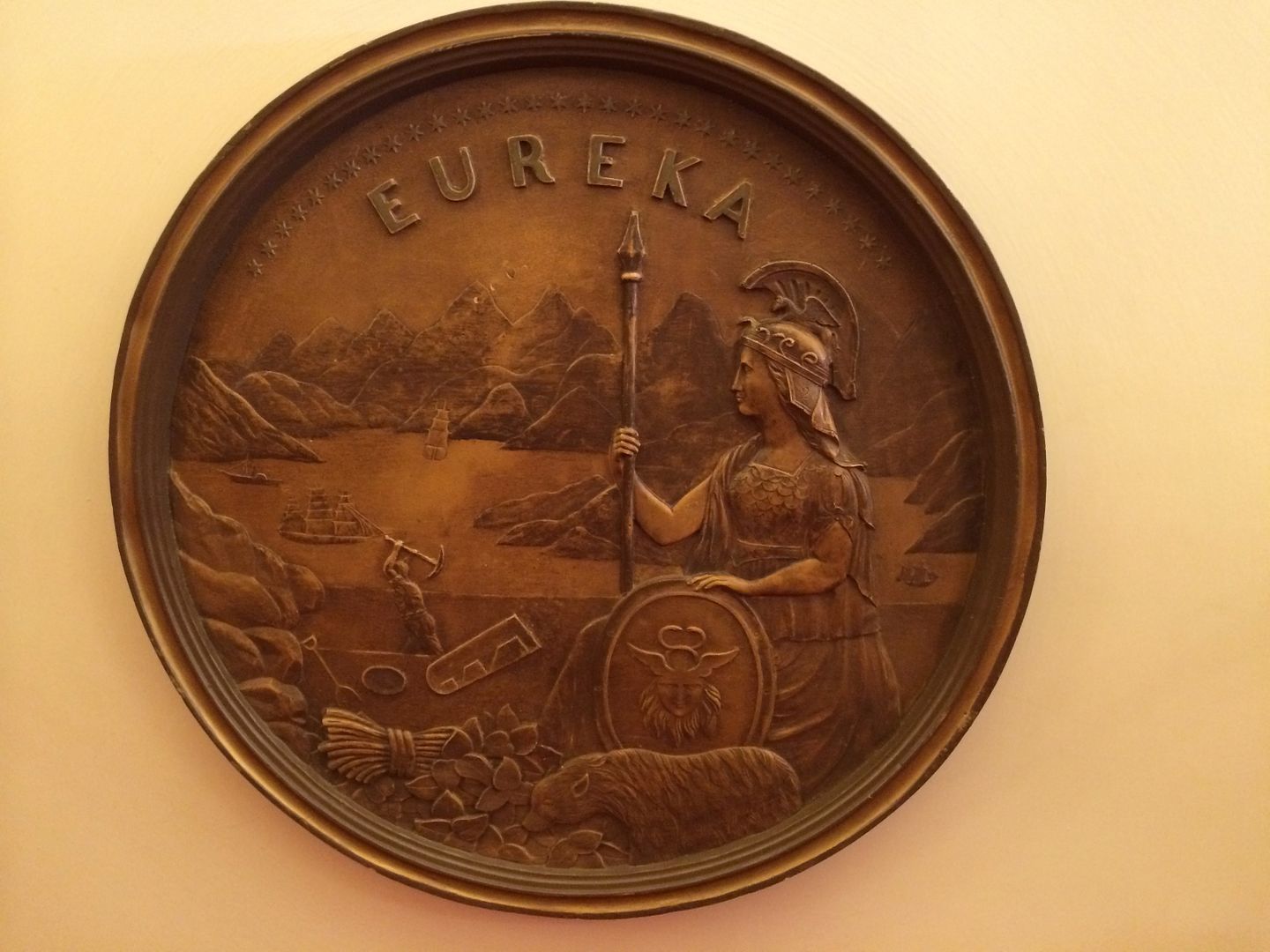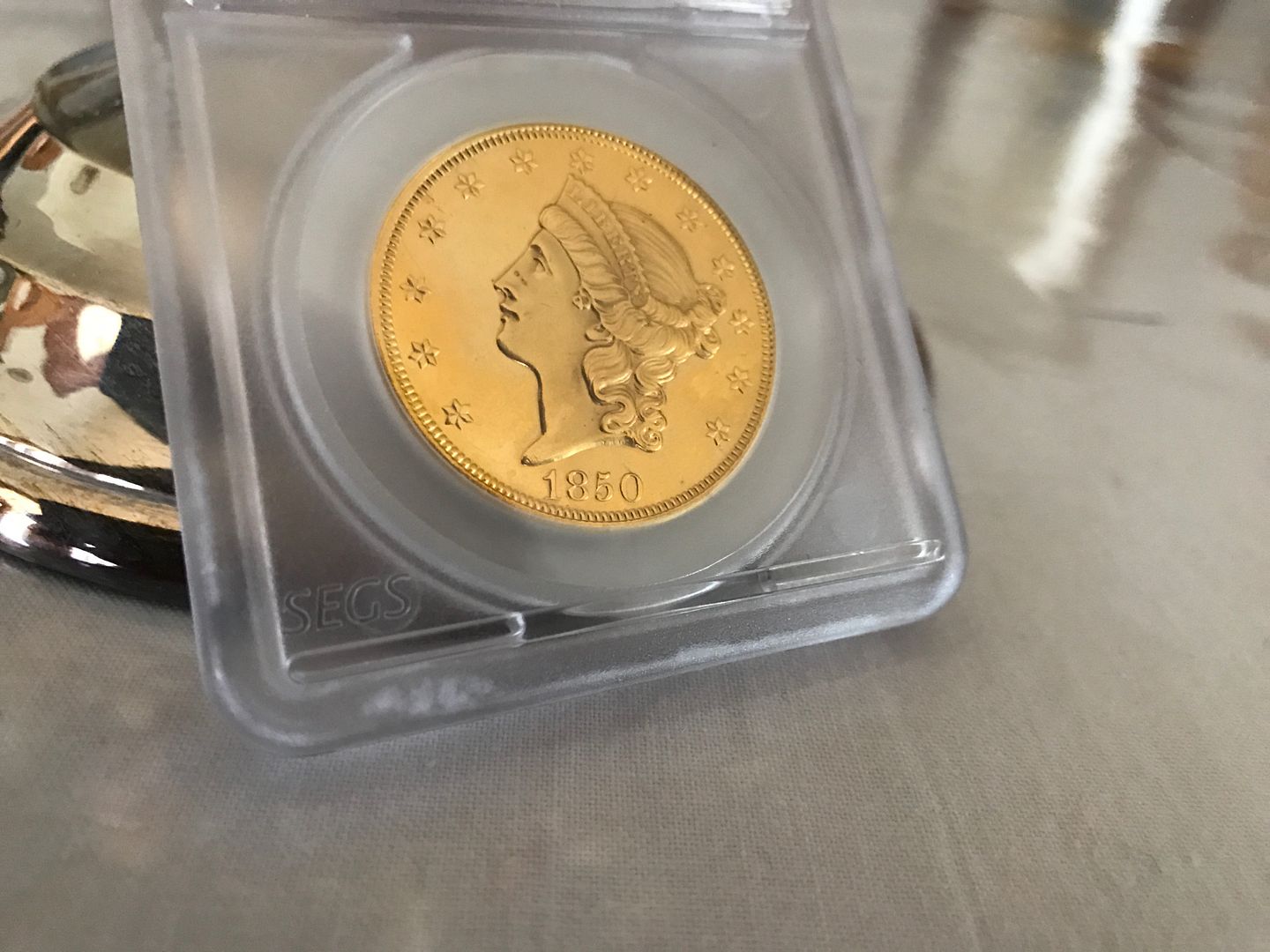170th Anniversary of U.S.'s 1st $20 circulated Gold and birth of the Gold Rush town of Eureka, CA
 1northcoin
Posts: 5,080 ✭✭✭✭✭
1northcoin
Posts: 5,080 ✭✭✭✭✭
For those interested in California Gold Rush history ----
This year marks the 170th anniversary of both the 1850 founding of the California Gold Rush town of Eureka and the 1850 $20 Gold Pieces - the first Double Eagles minted by the United States to be placed into circulation. Interestingly Eureka took its name from the newly adopted California State Seal with its incorporated single word State Motto, "Eureka" as described below.
"Around the bevel of the ring are represented thirty-one stars, being the number of the States of which the Union will consist, upon the admission of California. The foreground figure represents the goddess Minerva [Greek: Athena], having sprung full-grown from the brain of Jupiter [Greek: Zeus]. She is introduced as a type of the political birth of the State of California, without having gone through the probation of a Territory. At her feet crouches a grisly [grizzly] bear, feeding upon clusters from a grape vine, which, with the sheaf of wheat, are emblematic of the peculiar characteristics of the country. A miner is engaged at work, with a rocker and bowl at his side, illustrating the golden wealth of the Sacramento, upon whose waters are seen shipping, typical of commercial greatness; and the snow-clad peaks of the Sierra Nevada make up the back-ground. Above, is the Greek motto "Eureka," (I have found it,) applying either to the principle involved in the admission of the State, or the success of the miners at work.
— 10px, 10px, Bayard Taylor, "Bayard Taylor's Letters, No. XXVII – The Great Seal of the State of California", New York Weekly Tribune, 22 December 1849, 1"
Pictured, my photo of the California State Seal taken in the state's capital located in Sacramento, California:

The town of Eureka today is the largest city on the Pacific Coast between San Francisco and Portland, Oregon. Its founding was right out of the California Gold Rush as its original purpose was to provide support for the gold mines located eastward of it.
Likewise, the 1850 entered into circulation $20 gold pieces had their origin also arising out of the California Gold Rush. Q. David Bowers in his 1,055 page tome, "A California Gold Rush History" describes the vast quantities of gold that flowed from California to the Eastern mints in Philadelphia and New Orleans where it was minted into the newly authorized $20 gold coins. At pages 489-490 Bowers writes,:
**"Although federal $20 coins were not made in pattern form until 1849 and for circulation until 1850, the idea was hardly new. ....
.In 1849 in Salt Lake City the Mormons struck gold coins of this value, the first such American issue. .....
Chief Engraver James B. Longacre, who had recently completed dies for the new gold dollar, set about creating the double eagle.
..... Several pattern $20 coins were struck in December 1849, of which only one gold impression is known today, residing in the Smithsonian Institution. Beginning in 1850, double eagles were produced in quantity for commerce. ..... Incoming gold from California represented the source for most of the metal."**
Below pictured is my 1850 Double Eagle which given its attribution to Dr. C.W. Green can be through auction history traced back to having been in the personal collection of its designer, James B. Longacre and as such, along with its unique appearance, may well be one of, if not the first, $20 double eagle struck at the Philadelphia Mint for circulation. It was first sold in Longacre's 1870 estate auction where it was referenced as a "proof." Max Mehl in a subsequent 1949 auction described the coin stating, "I classify it as a brilliant semi-proof, almost equal to a brilliant proof." Its most recent auction appearance was at the 2001 Superior Galleries' "Pre-Long Beach Sale with the auction description stating, "This coin has a beautiful bold strike with full stars and all other details sharp and clear. The fields are Prooflike ..." I acquired it shortly thereafter.

Based upon a contemporary newspaper account we know that the first $20 double eagles entered circulation at least by the spring of 1850. Mint records record that later in the fall of 1850 a set of proof gold coins was assembled which included a then minted proof $20 double eagle. That set is the likely source of the one known to exist 1850 Proof Liberty Head Double Eagle which eventually ended up in a Paris museum where it remains located to this day.
Comments
Thanks for the post ... it's interesting stuff!
Beautiful and very historic coin! Thanks for the history!
Stupid question: why is it in a SEGS holder?
Because of its recognition therein in the original Coin Facts where it was identified as the first "Significant Example" of the 1850 double eagle, as well as its description in its most recent 2001 auction appearance.
Very interesting... I do have Bowers "A California Gold Rush History" (autographed), and thoroughly enjoyed it. Having panned gold in several states and New Zealand, gold has a special interest for me....not to mention long hours bent over a pan in a stream... Cheers, RickO
Cheers, RickO
Thanks for all the comments and kudos to those who read through to the end to get to the numismatic commentary.
Good post. Thanks.
It was first sold in Longacre's 1870 estate auction where it was referenced as a "proof." Max Mehl in a subsequent 1949 auction described the coin stating, "I classify it as a brilliant semi-proof, almost equal to a brilliant proof." Its most recent auction appearance was at the 2001 Superior Galleries' "Pre-Long Beach Sale with the auction description stating, "This coin has a beautiful bold strike with full stars and all other details sharp and clear. The fields are Prooflike ..." I acquired it shortly thereafter.
That set is the likely source of the one known to exist 1850 Proof Liberty Head Double Eagle which eventually ended up in a Paris museum where it remains located to this day.
Credit goes to Roger Burdette for his research locating the United States Mint records that confirm that the proof specimen of the 1850 Double Eagle was not made until approximately October of 1850. That would have been at least half a year after the one kept by Longacre in his personal collection as discussed and pictured above.
Roger's research finding:
Yes, there was at least one (1) 1850 double eagle proof ("master coin") made along with the rest of a set of 1850 gold.
Mint of the United States
Philadelphia
September 26, 1850
Hon. Thomas Corwin,
Secretary of the Treasury
Sir,
I have the honor to acknowledge the receipt of your letter of yesterday,
respecting an application made by the Committee on the Library for a series of
“Specimens of gold coins.” I presume that these specimens include one set of
Gold Master Coins, and I have the satisfaction to say that these can be furnished
without delay.
The number of coins will be five, and their cost $38.50
Very respectfully,
Your faithful servant,
R.M. Patterson, Director
[Note supra: Copy sent to Com Library 27 Sept.]
[RG104 entry 216 vol 08 - 18500926 specimen gold coins]